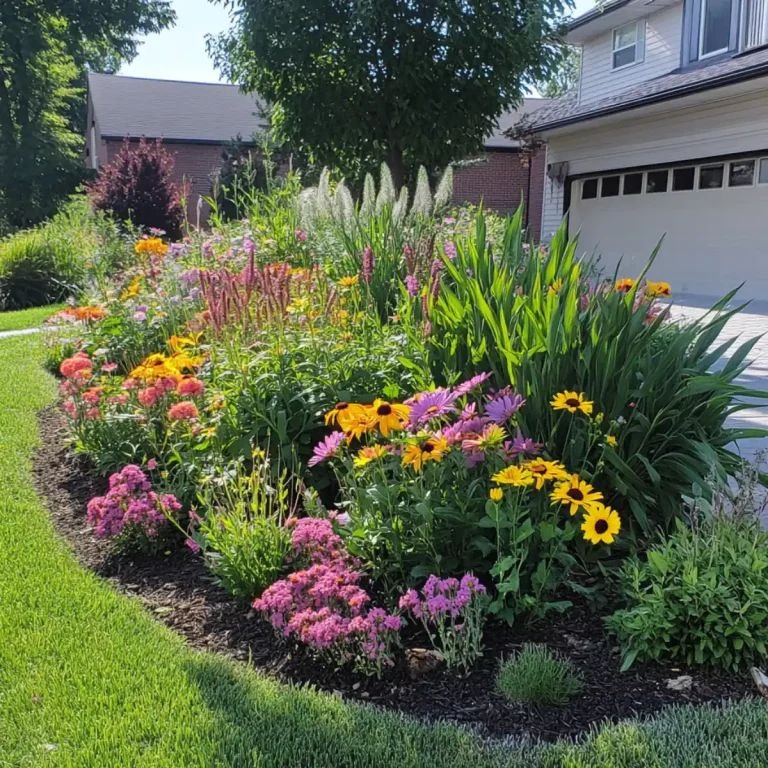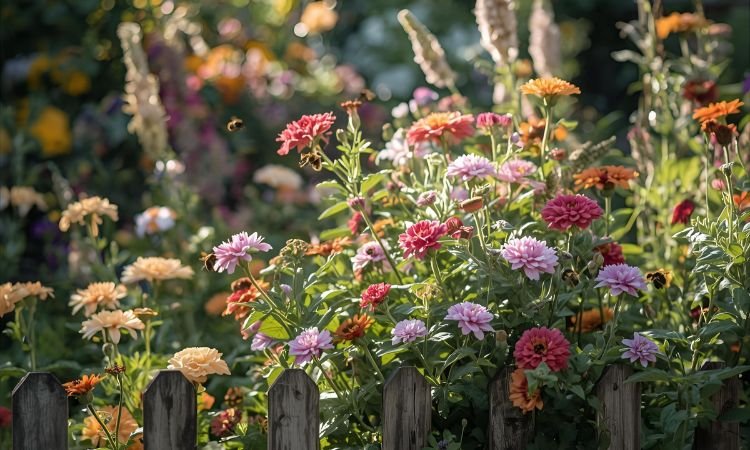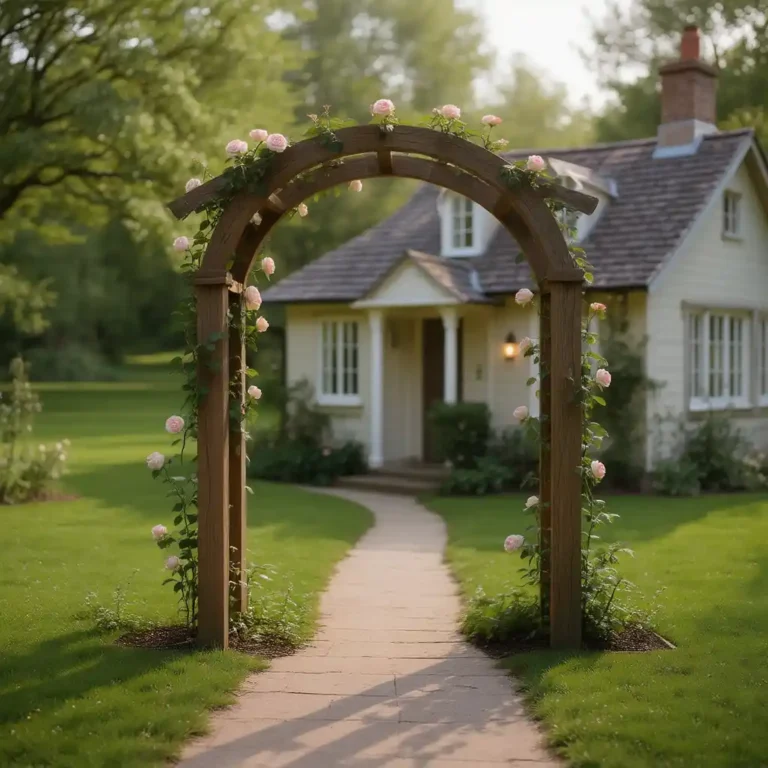19 Stunning Wood and Wire Fence Ideas That Will Transform Your Garden!

This topic has me craving fences that feel warm and easy to weave into a garden. Wood and wire can add privacy, light, and a touch of charm. Here is why I made this post. I want to help you choose a fence that fits your yard, budget, and vibe.
If you enjoy DIY projects, small backyards, or cottage garden styles, this one’s for you. You care about making your space feel cozy, functional, and a bit unique. You want ideas you can actually build without a big crew.
I pulled together 19 wood and wire fence ideas. They are practical, stylish, and doable for many spaces. What you’ll get is 19 ideas that mix wood and wire for texture and light. Each idea comes with simple, real-life steps you can try soon.
From low borders that keep dogs in and flowers in to taller screens that block glare, these fences cover a lot. Think slatted panels paired with galvanized wire, leaning lattices, or a gate that doubles as a trellis. I share quick steps and materials so you can plan and buy with confidence.
Wood needs finish and a yearly check for rot. Wire should be rust resistant and tied well. Paint colors can brighten a small yard or blend with a cottage style. Match posts to soil and set them a bit deep for wind.
Insider Tips for Wood and Wire Fences
Imagine your garden transformed with a striking wood and wire fence, blending rustic charm and modern openness to create a breathtaking boundary. These budget-friendly ideas will elevate your outdoor space, perfect for small or large gardens, offering style and functionality that wow guests.
- Horizontal Wood and Wire Panels: Use horizontal wood slats with wire mesh infills for a sleek, modern look that balances privacy and openness. It’s like your garden’s embracing contemporary elegance.
- Rustic Post-and-Wire Design: Pair weathered wood posts with galvanized wire for a farmhouse vibe that’s both sturdy and charming. It feels like your garden’s channeling timeless rural appeal.
- Wood Frame with Hog Wire: Frame hog wire with stained wood for a minimalist, industrial aesthetic that showcases plants. It’s like your fence is framing a living garden gallery.
- Vertical Wood with Wire Accents: Alternate vertical wood planks with wire sections for a rhythmic, eye-catching pattern. It’s like your garden’s dancing with structured creativity.
- Reclaimed Wood and Chicken Wire: Use salvaged wood with chicken wire for an eco-friendly, boho-chic fence that’s budget-friendly. It feels like your garden’s weaving sustainable style.
- Wood and Wire Trellis Combo: Combine wire mesh with wood beams to support climbing vines, blending function with natural beauty. It’s like your fence is growing with lush charm.
- Stained Wood with Black Wire: Stain wood frames dark and pair with black wire for a bold, modern contrast that pops. It’s like your garden’s strutting with sophisticated flair.
If you are ready, choose a look that fits your space. Start with a small corner and build from there. Let your garden guide the finish and height. Next steps: pick a couple of ideas to sketch and estimate materials.
1. Rustic Pallet Perfection

You want a fence that adds charm to your garden without a big price tag. A pallet fence fits that need. It uses reclaimed pallets and shows weathered wood with real character. You get a rustic look that blends with herbs and blooms. It’s easy to build, quick to finish, and kind to the planet. You can paint it, stain it, or let vines hug the boards for living art.
Here is how to make it work:
– Choose solid pallets with tight boards and no rot. Inspect several pallets to pick the strongest pieces.
– Dismantle them carefully. Remove nails and separate boards.
– Sand rough edges so you won’t snag skin or clothing.
– Decide on the finish. Paint bright, stain warm, or leave the wood natural to show grain.
– Seal the wood with outdoor sealer or weatherproof varnish to guard against rain and sun.
– Build the frame with vertical boards or lay the panels horizontally. Secure with screws to sturdy posts so the fence stands strong.
– Let climbing vines grow on it. Create a living wall that hides the base and adds color.
– Check periodically. Tighten screws and reapply sealer every few years.
In small yards, it doubles as a backdrop for flowers. In bigger spaces, it marks paths while still letting light through.
Transform your garden with a rustic pallet fence—it’s charming, eco-friendly, and budget-friendly! With just a few reclaimed pallets, you can create a stunning backdrop for your blooms and vines. Let your creativity flow!
2. Contemporary Wire and Wood

If you want a fence that looks clean and current, a contemporary wire and wood design fits.
Picture vertical wooden slats with taut wire running between them. It creates an open, stylish frame for your garden. We keep the view in mind.
Here is why it works:
– It lets you see through the fence while still giving you a defined border.
– You can set the height and pick a wood finish that suits your yard.
– It invites climbing plants to grow along the wires, adding color and texture.
What you gain is a chic barrier that adds form and function. It works well in modern, cottage, and urban gardens alike.
Next steps:
– Choose wood such as cedar or FSC pine. Pick a light stain or a natural seal to keep the grain visible.
– Plan your spacing. For most yards, 4 to 6 feet tall is a good balance of view and privacy.
– Install the wire carefully. Run it taut and keep the posts sturdy.
– Add plants. Clematis, climbing roses, or ivy can cover the slats fast.
Tips and limits:
– This style is great for gentle wind areas but expect some sway in heavy gusts.
– It won’t block sound or totally hide a busy yard.
With care, your fence stays simple, strong, and stylish.
3. Vertical Garden Fence

Vertical Garden Fence: Grow up, not out
You want a fence that feels alive. A vertical garden fence can give you that. It adds height, color, and a hint of shade you can touch.
Here is how to set it up:
– Pick sturdy wooden panels as a solid base.
– Attach a wire grid to the panel.
– Train plants as they grow with string or clips.
– Leave space behind the grid for air flow and easy access.
Plant ideas you can start now:
– Sweet peas for a sweet scent and bright, fluttering blooms.
– Climbing roses for a romantic touch and long stems.
– Pole beans or cucumbers for a tasty harvest right at eye level.
This turns your fence into a living wall you can see, smell, and touch.
Care and upkeep:
– Give the wall a sunny spot. Most climbers love at least six hours of light.
– Water at the base and mulch to slow evaporation.
– In spring, train new shoots and prune after flowering to keep the structure tidy.
Next steps:
– Check the grid for loose wires. Tighten as needed.
– Add a drip line or a soaker hose if you want easier watering.
Seasonal notes: You can swap plants as the year changes. Start with peas in spring, then try roses or beans as summer comes.
| Fence Style | Materials | Key Features | Maintenance Tips |
|---|---|---|---|
| Rustic Pallet Perfection | Reclaimed pallets | Eco-friendly, rustic look, easy to build | Check screws and reapply sealer every few years |
| Contemporary Wire and Wood | Cedar or FSC pine, wire | Stylish, open design, invites climbing plants | Check for sway in heavy winds, maintain wire tension |
| Vertical Garden Fence | Wood panels, wire grid | Adds height, supports climbing plants | Water deeply, mulch, and prune regularly |
| Mixed Material Marvel | Wood, wire, stone | Warm, sturdy, visually appealing | Stain wood every few years, low maintenance stone |
| Colorful Garden Fence | Weatherproof paint, wood | Brightens space, customizable colors | Seal with clear top coat, clean regularly |
| Artistic Trellis Design | Wood, outdoor screws | Supports climbing plants, customizable patterns | Water and prune vines, check for loose wires |
| Edible Fencing | Wire panels, sturdy posts | Supports edible plants, functional and attractive | Water deeply, guide vines, trim as needed |
4. Mixed Material Marvel

Mixed material fences catch the eye and stand up to weather. If you want a boundary that feels warm yet sturdy, try wood, wire, and stone together.
Here is why it works:
– The stone base sits firm and lifts the wall off the ground.
– Horizontal wood slats add warmth and texture.
– The wire lets light pass through and keeps the fence from looking bulky.
– Each material can be painted or stained to match your house and garden.
What to plan
– Start with a level stone base, then cap it with wood slats across.
– Attach the wire to hold the frame and support edging plants along the edge.
– Choose colors that fit your yard: natural stone, weathered wood, and muted wire.
Practical ideas
– Plant along the base. A low ground cover or grasses soften the line and hide the seam.
– Maintenance varies. Wood needs staining every few years; stone stays low maintenance; wire lasts with rust resistance.
– Use this fence to frame paths or mark a seating area.
Next steps
– Sketch a quick plan with stone width, wood height, and wire position.
– Check local rules for fence height and material restrictions.
This setup lets you swap looks later by changing the wood slats or the stone cap.
5. Colorful Garden Fence

Here is why you want a colored fence. It sets the mood, ties your garden to the house, and makes areas you love stand out. You can pick colors that match windows, chairs, or flowers. A splash of color wakes a quiet yard.
Here is how to do it well:
– Choose outdoor paint: Look for weatherproof wood paint. Latex or enamel works best. It sticks and lasts in sun and rain.
– Prep the fence: Clean with a stiff brush. Rinse and dry. If the wood is rough, sand lightly. Patch small cracks.
– Set a color plan: Try sunny yellow, sky blue, mint, or soft pink. A gradient adds style. Start dark at the bottom and fade up.
– Add patterns: Stencils make simple designs. Stripes, checks, or dots add charm.
– Paint with care: Roll large areas. Brush edges. Use two thin coats. Let each coat dry.
– Protect and refresh: Seal with a clear outdoor top coat if you want extra protection. A light hose spray keeps colors bright.
Next steps: test a small patch first. Then pick your palette and plan a painting day. Your fence will catch the eye and lift your garden.
6. Artistic Trellis Design

You want a fence that feels alive and tidy. A wooden trellis gives climbing plants a home. It adds height and color and softens the edge.
Here is why it works. It creates shade, scent, and a natural screen. Vines fill gaps and soften borders. It’s simple to change later if you want a new look. Let’s break it down into simple steps.
Pattern ideas
– Cross-hatch for a bold, architectural feel.
– Diamond lattice for a classic garden vibe.
– Simple vertical slats for a clean, modern touch.
Frame it right
Choose sturdy wood. Cedar or treated pine lasts longer outside. Build a square or rectangle frame to fit your fence. Add cross pieces to form the chosen pattern. Use outdoor screws and weather-proof paint or stain. Leave small gaps so air moves and the frame stays steady.
Plant and care tips
Pick vines that cling or twine, such as clematis, climbing roses, or morning glory. Plant along the base and guide stems through the pattern. Tie loosely with soft ties. Water deeply in dry spells. Prune after flowering to keep the shape neat.
Easy upgrades
Add a bench nearby for a cozy reading nook. Use colored wires if you want a playful twist. A few pots or hooks on the frame add extra charm.
Next steps plan your fence width, choose a pattern, and grab your supplies. Then build and watch your garden grow.
7. Lattice Work Fencing

Lattice Work Fencing
You want a fence that frames your garden but keeps it bright. Lattice panels made of wood create a light, friendly boundary.
Here is why lattice fits well in many yards:
– It adds style without shutting off the view.
– It lets sun reach plants and a soft breeze pass through.
– It invites climbing plants to grow, turning the fence into a living wall.
– It can be painted or stained to match your house or stand out as a feature.
How to use and install:
– Attach wooden lattice panels to sturdy posts with outdoor screws.
– Pick a pattern (diamond or square) and choose a height that fits your beds.
– Seal the finish to stop rot and extend life.
Practical ideas you can try:
– Wrap a border with vines to create shade for herbs.
– Place lower panels by pathways to keep the yard open and safe.
– Train roses, clematis, or ivy along the fence for color and scent.
Care and maintenance:
– Check for loose slats and tighten screws a couple of times a year.
– Repaint or restain every few years to refresh the look.
– Clean with a gentle spray and let it dry fully before rain.
Next steps:
– Plan the layout on paper, then buy a few panels to test the look.
– Add a small trellis at corners to guide new growth.
8. Solar-Powered Fence Lights

– What solar lights do for you They provide a warm glow after dark. They run on sun power. They charge the battery during the day. The lights turn on automatically at dusk.
– Where to put them Place along the top rail for a clean line. You can tuck some inside the wire mesh to glow through the gaps. Add a light by the gate for extra safety. They work on curved fences too.
– How they work Each unit has a solar panel, a battery, and an LED. The panel collects sun rays. The battery stores the energy. At night the LED lights up.
– Benefits at a glance No wiring is needed. They save energy. They cost little to run. They boost safety by outlining the fence.
– Simple install steps Pick sunny spots on the fence. Mount the lights with screws or clips. Aim the LEDs along the yard. Turn on the unit and let the sun do the rest.
– Tips for best results Clean the solar panels every few months. Use several lights for even coverage. Check winter sun and battery performance.
– Common questions Will they work on cloudy days? They charge when the sun shines. Are they bright enough? Add more lights for more glow. Can I install them myself? Yes, they clip or screw on with basic tools.
9. Farmhouse Style Fence

Here is why you should consider a farmhouse style fence. It brings warmth and a simple, honest look to your yard.
Let’s break it down. A wood and wire fence blends two textures. Horizontal slats give clean lines. Wire panels add a touch of rough charm. You get a boundary that feels welcoming, not stern.
Next steps to achieve the look:
– Materials: pick weatherproof wood and sturdy wire. Reclaimed wood adds character and is cheaper.
– Finish: whitewash for a classic farmhouse glow, or a light stain to keep the wood grain visible.
– Construction: set posts firmly. Attach horizontal slats at even gaps. In between, fit wire sections for texture and airflow.
– Colors: keep it pale. White, soft gray, or faded cream to keep the cozy vibe.
What this fence does for your garden:
– Defines space without blocking the view.
– Complements plants with a rustic backdrop.
– Ages nicely, developing a warm patina over time.
Maintenance tips:
– Check for loose boards or rusted wire once a season.
– Brush off dirt and reapply stain or wash once every few years.
– Seal the wood to resist rain and sun.
Common questions:
– Is it durable? Yes, with proper posts and tension.
– How much work? It takes a weekend to set up and a few days to finish.
Bottom line: a farmhouse fence adds character and charm while staying practical.
10. Simple and Sturdy

If you want a fence that keeps pets in and plants out, this simple style might be your best bet. Your garden stays safe, and your yard looks tidy at the same time.
<Why this approach works>
– It is strong enough to hold up wind and small animals.
– It is easy to care for and cheap to install.
– It stays neat with a quick paint refresh when you want a new look.
<What you’ll need>
– Treated wooden posts for longevity.
– Sturdy galvanized wire that won’t rust.
– Basic tools: tape measure, shovel, post hole maker, and a staple gun.
– Quick-setting concrete and a brush for paint or stain.
<How to build it>
– Mark a straight line where you want the fence and choose a height that fits your needs.
– Dig post holes about 18 to 24 inches deep and space posts 6 to 8 feet apart.
– Set the wooden posts in concrete and let them firm up.
– Run the galvanized wire along the posts and secure it with staples or wire ties.
– Tension the wire so it’s snug but not tight.
– Add a simple cap or trim and give the fence a fresh coat of paint.
Maintenance tips>
– Check the wire every season and tighten if it sags.
– Repaint or seal every few years to keep wood from cracking.
Limitations>
– It won’t stop a determined climber or high theft risk.
– It works best for clear boundaries, not heavy privacy.
Next steps>
Measure your space, pick a height, and make a simple plan. You’ll have a clean, sturdy fence you can build in a weekend.
11. Bohemian Chic Fence

Here is why a bohemian chic fence fits your garden. It adds warmth and charm without a big budget. You get color, texture, and a playful vibe. You will see movement when the wind moves fabrics and tassels.
Next, what it is and how it helps. A wooden or wire fence becomes a canvas for bright fabrics and macrame hangings. The mix turns a plain boundary into a feature your eye follows. It invites you to linger and notice small details.
Prep your fence
Clean the wood or wire.
Fix loose boards and rusty hooks.
A solid base helps the decor last.
Choose weather-safe fabrics
Outdoor cotton or synthetic fabrics work well.
Pick colors that echo your garden beds.
Think soft hues or bold contrasts.
Add macrame and hangings
Use simple knots and different lengths.
Attach with zip ties or weatherproof hooks.
Space pieces so light can pass through.
Layer textures
Mix tassels, woven rugs, and rope accents.
Avoid crowding the surface.
Let some fabric drift in the breeze.
Pair with plants
Add trailing vines or pots near the fence.
The greenery ties the look together.
Care and maintenance
Use a spray for weather resistance.
Check hooks seasonally and replace worn pieces.
Your fence becomes a welcoming garden feature. It boosts curb charm and personal style.
A bohemian chic fence invites creativity into your garden! Transform a simple boundary into a vibrant canvas of color and texture, making your outdoor space a playful retreat.
12. Privacy with Style

If you want real privacy in the garden without losing charm, try a tall wood and wire fence. You get seclusion and a clean look at once. Start with wooden panels that rise high, then cap them with wire mesh for extra security. Inside, plant tall hedges along the fence line. They add cover.
Here is why this works:
Dense wood blocks sight and keeps sounds a touch quieter. Vines climbing the mesh soften the edges and bring green to your view. A dark stain or dark paint gives a modern, crisp finish.
– Pick dense wood with tight grain for better blocking.
– Let climbing plants cover gaps and add movement.
– Use a dark stain to match contemporary yards.
This setup helps your garden stay a calm retreat, not a locked yard.
Next steps:
– Measure the space and decide on height, then choose panels and mesh.
– Attach the mesh securely to the top of the panels and seal edges near the ground.
– Plant a fast-growing hedge inside and train vines to climb the mesh.
– Maintain by pruning hedges and checking fasteners twice a year.
– If you wish, add a matching mesh gate for a clean look.
Common limits:
– Tall fences take effort to build; check local rules.
– Strong winds can rattle loose parts; use solid posts.
End note: privacy can be stylish if you plan and care for it.
Latest Posts
- Kids Room Curtain Ideas That Balance Function and Fun

- Backyard Deck Ideas That’ll Transform Your Outdoor Space Into Something Special
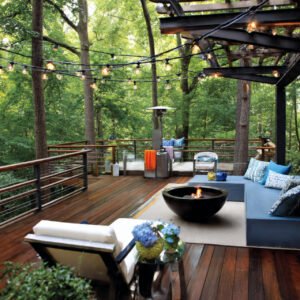
- Modern Living Room Designs That’ll Make You Want to Redecorate ASAP

- Garden Pergola Ideas With Roof That Provide Real Protection

- Garage Pergola Ideas That Turn Plain Parking Areas Into Design Features

- Small Patio Dining Ideas That Make Outdoor Meals Possible
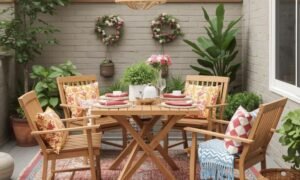
13. Garden with a View

You want a garden that shows off the view, not blocks it. A transparent wire fence does the job. It marks space and keeps plants safe, while the scenery stays in full view.
Here is why this option works: you gain an open feel. You still see a garden edge. Kids and pets stay inside. The air moves through, so beds stay fresh and cool on hot days.
How to style:
– Use sturdy wire mesh to hold its shape and last through seasons.
– Pair it with a low wooden fence for a quiet border that adds warmth.
– Plant along the edge to frame the view. Choose climbers or tall grasses that rise toward the sightlines, guiding the eye toward what you love outside.
What to consider:
– Post spacing matters. Set posts closer where you have slopes or wind.
– Keep the wire tight and check for loose spots after storms.
– Let plants soften the edge without hiding the view.
Next steps:
Measure your space, pick a wire mesh and a companion fence, and sketch where you want plants. Start simple, then adjust as your garden grows.
It stays sturdy with little fuss. You will barely notice it after a season.
14. Treated Wood Elegance

You want a fence that lasts and looks right in your garden. Treated wood does that. It uses a preservative to fight rot and insects. Built right, it stands up to sun, rain, and soil.
Here is why you can style it your way. You can stain, paint, or keep a natural look. Add wire panels along the top or sides to create contrast and a modern feel. If you want more privacy, add a second rail or a taller panel.
Benefits of Treated Wood:
– Resists rot and decay.
– A long-lasting choice for your garden budget.
– Styles that fit many yard designs.
For best results, plan and install with care.
– Choose pressure-treated lumber for posts and rails.
– Use corrosion-proof screws and brackets.
– Set posts deep and square with proper spacing.
– Leave gaps for wood to move and dry.
Seal the wood after you install it to slow weathering.
Check for loose screws after storms.
Maintenance tips:
– Re-stain or re-paint every 2 to 3 years.
– Wash with mild soap and water.
– Check for loose boards and nails and tighten.
Next steps: Decide if you want wire accents. Pick a color or finish. Start a weekend project.
15. Garden Gate Inspirations

Your fence deserves a gate that feels part of the whole scene. A wooden gate that swings open invites you toward your garden, and adding wire elements ties it to the fence with a cohesive look. Let’s make your gate both practical and pretty.
Here are easy ways to style your garden gate:
– Add artistic cut-outs or gentle arches for a touch of whimsy that is still simple to build.
– Choose a finish that matches the fence with a stain, or go bold with a contrasting paint color.
– Decorate with hanging planters, a small lantern, or a tiny name plaque to boost charm.
Why these ideas work
A well designed gate acts as a warm welcome. It creates a clear entry point and sets the mood for the space beyond. A touch of wire can echo the fence, making the whole border feel unified rather than separate pieces.
Practical tips you can use now
– Plan the size: decide between a single or double swing gate and measure the opening with a little clearance for smooth operation.
– Pick materials: cedar or pressure treated pine holds up well; wire panels add a rustic vibe without heavy cost.
– Finish and hardware: seal the wood to resist weather; use rust resistant hinges and a sturdy latch. A simple, well built gate lasts longer and looks better over time.
Keeping it simple, you gain a gate that invites, lasts, and visually ties your fence to your garden.
16. Vintage Charm

Want a fence that feels timeless without breaking the bank? A vintage style wood and wire fence can do it. Choose weathered boards and a rusted wire mesh to hint at years gone by. You’ll gain character and a sense of history in your garden. It is also easy to adapt to small plots. A vintage fence ages with time and your garden.
– Material choices Go with reclaimed boards, pine, or cedar that show age. Skip glossy finishes. Let the grain tell a story.
– Weathering and paint Seal with a breathable finish in soft pastel tones. Light whitewash or pale blue creates old-time charm.
– Wiring and installation Attach rusted wire to sturdy posts. Space wires evenly. Use staples and pliers for a clean, secure look.
– Styling and planting Place nearby antiques or soft fabrics. Let climbing plants like roses and clematis weave along the wire.
– Maintenance tips Check posts for wobble each season. Reseal where needed. Trim plants to avoid moisture.
Here is why this look works. It pairs calmly with simple landscaping and small blooms. You can build it in a weekend with basic tools and reclaimed wood. Next steps: scout for boards, plan pastel colors, and start by placing a few posts.
A vintage wood and wire fence doesn’t just define your garden; it tells a story! Let reclaimed materials weave a narrative of character and charm while aging beautifully with your plants.
17. Artistic Fence Panels

You want a fence that does more than mark a boundary. Artistic wood and wire panels can become a focal point in your garden.
Here’s why artistic fence panels fit your yard:
– They add texture and character to a plain fence.
– They let you show your style in a simple, affordable way.
Design ideas to try:
– Geometric patterns for a clean, modern look.
– Leaves or waves for a natural feel.
– Color accents with weatherproof paint to highlight the cutouts.
Plan and install:
– Choose cedar or pine, based on climate and budget.
– Set panel size and the direction of the cut designs.
– Cut the patterns with a scroll saw or router, then sand edges smooth.
– Seal the wood to resist rain and sun.
Tips for success:
– Sketch your design on paper before cutting.
– Use weather-safe paints or stains and keep colors muted for a timeless look.
– Mix artistic panels with plain boards to save costs.
Maintenance and look:
– Check for warping after seasons and recoat every few years.
– Group three or more panels for a gallery feel and vary heights.
Common questions:
– Will it withstand wind? Add crossbars and use thicker boards.
– How long will it last? With proper sealing, several seasons to years.
Next steps:
– Measure the fence span.
– Sketch designs.
– Gather tools and start with one panel.
Artistic wood and wire fence ideas not only define your garden but also express your unique style. Let your boundary be a canvas for creativity – because a fence can be so much more than just a barrier!
18. Edible Fencing

You want a fence that fits your garden and feeds you. Edible fencing gives both. A wire fence acts as a backbone for vines and herbs. You get privacy and a fresh crop.
– Materials: Use sturdy wire panels, cattle panels, or welded mesh. Set posts solid in concrete or soil. A height of about 5 to 6 feet works well for tomatoes and cucumbers. Secure with zip ties or clips so the vines can crawl.
– Plants to start: Peas and pole beans climb fast and stay neat. Cucumbers and small gourds run along the mesh. Tomatoes need strong support at the top. You can tuck herbs or low greens at the base for easy harvest.
– How to train: Plant at the foot of the fence and guide vines with gentle ties. Come every week to weave new growth along the wires. Keep stems clipped so they don’t pull the fence loose.
– Care and harvest: Water deeply and mulch to preserve moisture. Harvest as pods turn color or beans plump. Trim back heavy vines after fruit sets to keep the fence sturdy.
Next steps: pick a sunny stretch, gather wire and posts, and plan your first crop. Your fence becomes a living border and a pantry.
19. Seasonal Decor Fence

Your fence can tell the story of the seasons. You want your garden to feel alive all year, not stuck with one look. Seasonal decor on a fence is an easy, affordable way to keep it fresh. It shines at dusk when lights glow.
Here is how to start. Keep it simple, swap pieces with the season, and reuse what you already have.
– Fall decor: Hang small pumpkins, gourds, and a leaf garland. Use lightweight hooks so you can swap pieces quickly. Stick to warm tones like orange and brown.
– Winter decor: Add evergreen sprigs, pine cones, red berries, and soft string lights. Keep items compact so the fence stays tidy. Choose weather-safe materials.
– Spring decor: Place a few cut flowers in jars, add moss, and tuck a small sign or bird nest among the vines. Let greens wake up the fence.
– Summer decor: Try bright banners, sun motifs, and climbing vines. Use solar lanterns for evenings. Keep things light so heat won’t sag the pieces.
Next steps: clip on reusable pieces, test in sun, and rotate monthly. If a piece won’t stand up to weather, switch it out.
This approach keeps your fence useful and your garden looking inviting through every season. Give it a try next weekend.
Frequently Asked Questions
Q: What Are the Benefits of Using Wood and Wire Fences in My Garden?
A: Wood and wire fences offer a perfect blend of functionality and aesthetics. They not only provide privacy but also allow for light to filter through, creating a warm and inviting atmosphere in your garden. Additionally, they can be an excellent backdrop for climbing plants and flowers, enhancing your garden’s overall beauty.
These fences are versatile, allowing for various designs, from rustic to modern, ensuring that you can find a style that complements your garden design.
Q: How Can I Create a DIY Wood and Wire Fence on a Budget?
A: Building a DIY wood and wire fence can be both fun and budget-friendly! Start by gathering materials like reclaimed wood or pallets, which can often be sourced at little to no cost. For the wire, consider using galvanized wire for durability. You can follow simple tutorials online that guide you through the process of constructing various styles, such as a pallet fence or a contemporary wire and wood design.
Don’t forget to check your local regulations regarding fence height and placement before starting your project!
Q: What Styles of Wood and Wire Fences Work Best for Different Garden Designs?
A: The style of your wood and wire fence should complement your garden’s overall theme. For a rustic garden, consider using a pallet or vintage style fence that adds character. If you aim for a modern look, a contemporary design with clean lines and taut wire would be perfect.
For a more vibrant space, a colorful garden fence can tie in with your flowers and furniture. Whatever your choice, ensure that the fence reflects your personal style while enhancing the beauty of your garden.
Q: Can I Incorporate Climbing Plants with Wood and Wire Fences?
A: Absolutely! Wood and wire fences are ideal for supporting climbing plants. The wire can act as a trellis, allowing vines and flowers to grow upward, adding height and vibrancy to your garden space. Consider using plants like clematis or morning glories that thrive on vertical structures. This not only beautifies your fence but also creates a more lush, green environment in your garden.
Just be sure to check the growth habits of the plants you choose to ensure they are suitable for your fence design!
Q: How Do I Maintain My Wood and Wire Fence to Ensure Longevity?
A: Maintaining your wood and wire fence is crucial for its longevity. Start by regularly checking for signs of rot or rust. If you notice any issues, address them promptly to prevent further damage. Applying a protective sealant on the wood can help resist the elements, while keeping the wire clean will prevent rusting.
Additionally, trimming any overgrown plants nearby will help keep your fence looking tidy and prevent moisture buildup. With a little care, your wood and wire fence can remain a stunning feature in your garden for years to come!
Conclusion
With these 19 wood and wire fence ideas, your garden can transform into a stunning sanctuary.
From rustic to modern, there’s an option to fit every style and need.
Get inspired to define your space while enhancing your garden’s beauty!




